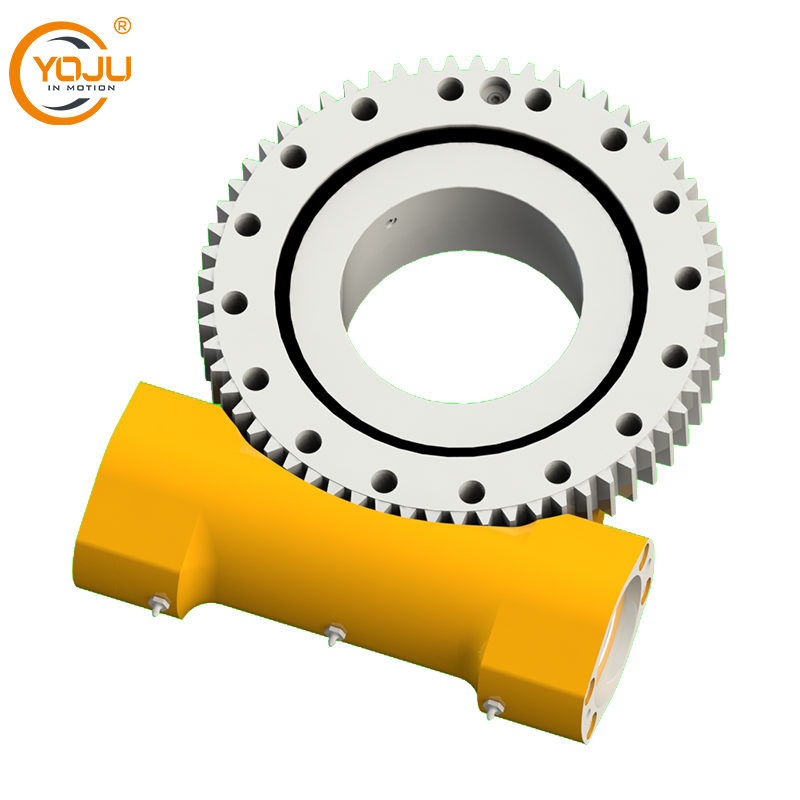In the field of automation, mini rotate platform slewing drives are key components for achieving precise movement and positioning. This compact and versatile device is used in a variety of applications from monitoring systems to industrial machinery. In this blog post, YOJU will share the manufacturing process of mini rotate platform slewing drive for sale, exploring the materials, technologies, and quality control measures that ensure their reliability and performance.
What is a Mini Rotate Platform Slewing Drive?
Before we dive into the manufacturing process, it's essential to understand what a mini rotate platform slewing drive is. At its core, it's a mechanical device that allows for the rotation of a platform around a single axis. This is achieved through a combination of gears, motors, and control systems. The "slewing" aspect refers to the smooth, controlled movement that the drive provides, which is crucial for applications requiring high precision.
Materials Selection
1. Aluminum Alloys: For the housing and structural components, aluminum alloys are often chosen due to their lightweight and high strength-to-weight ratio. They also offer excellent corrosion resistance, which is vital for longevity in various environments.
2. Stainless Steel: For components that require high durability and resistance to wear, stainless steel is used. It's particularly important for the gears and bearings that endure constant motion.
3. High-Strength Plastics: In some cases, high-strength plastics are used for non-structural components to reduce weight further without compromising durability.
4. Electrical Components: The motors and control systems require high-quality electrical components, including copper wiring for conductivity and precision-engineered circuit boards.

Manufacturing Process
1. Design and Prototyping: The process begins with the design of the slewing drive, which is then turned into a prototype. This stage involves extensive computer-aided design (CAD) work and 3D printing to create a physical model for testing.
2. Casting and Machining: Aluminum alloy components are often cast using a precision die-casting process to ensure accuracy and consistency. After casting, these parts are machined to precise dimensions using CNC (Computer Numerical Control) machines.
3. Forging and Fabrication: Stainless steel components may be forged to achieve the desired shape and strength. This process involves heating the metal and then shaping it using tools and dies.
4. Assembly: The various components are assembled using precision tools and techniques. This includes the installation of gears, motors, and control systems. Each part must be aligned perfectly to ensure smooth operation.
5. Wiring and Electronics: The electrical components are wired according to the design specifications. This step requires meticulous attention to detail to avoid any short circuits or malfunctions.
6. Testing: Each unit undergoes rigorous testing to ensure it meets performance standards. This includes testing for torque, speed, and endurance under various conditions.
7. Quality Control: Throughout the manufacturing process, quality control checks are performed to ensure that each component meets the required specifications. This includes visual inspections, dimensional checks, and material testing.
Key Manufacturing Techniques
1. CNC Machining: Computer Numerical Control (CNC) machining is a process used in the manufacturing of the slewing drive's components. It allows for high precision and repeatability, ensuring that each part is made to exact specifications.
2. Precision Casting: For components like the housing, precision casting ensures that the parts are made with minimal material waste and maximum accuracy.
3. Laser Cutting: For some components, laser cutting is used to achieve the required precision and cleanliness of the cut edges.
4. Robotic Assembly: In some manufacturing facilities, robots are used to assemble the slewing drive. This method increases efficiency and reduces the chance of human error.
Quality Control Measures
1. In-Process Inspections: Regular inspections are conducted throughout the manufacturing process to ensure that each step is performed correctly.
2. Final Testing: Before the slewing drive leaves the factory, it undergoes final testing to ensure it meets all performance criteria.
3. Certification: The slewing drive may need to be certified to meet industry standards, which involves additional testing and documentation.
Conclusion
The manufacturing process of a mini rotate platform slewing drive is a complex and meticulous endeavor. It involves a combination of advanced materials, precision engineering, and rigorous quality control measures. By understanding this process, we can appreciate the level of expertise and care that goes into creating these essential components of modern machinery.
https://www.enyoju.com/Manufacturing-process-of-mini-rotate-platform-slewing-drive.html
www.enyoju.com
YOJU
